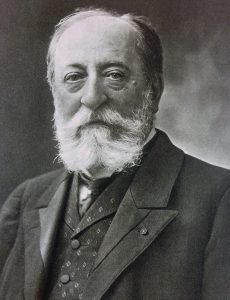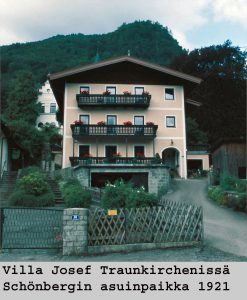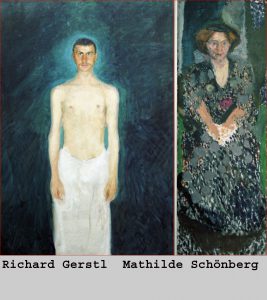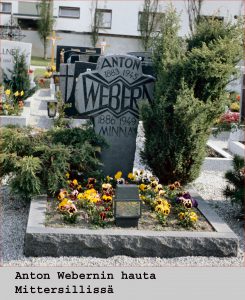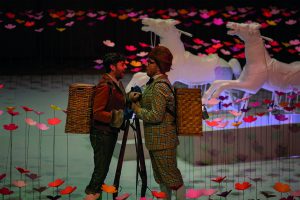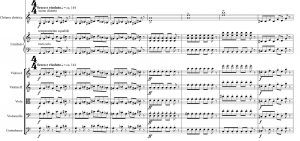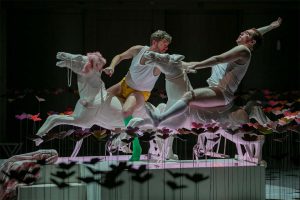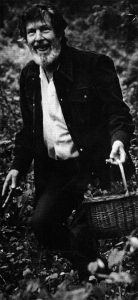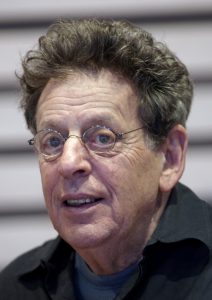
Philip Glass
I hardened my heart against these sounds for I loved him,
for all his madness, and perhaps I loved him the more because of it,
for his madness was more beautiful than the wisdom of other men.
Sinuhe (Waltari, 1945/1949 p. 303)
Akhnaten was a human being like most of us. He “seems to have been a good friend, as he was a stern enemy” (Weigall, 1910/1922, p. 192). Still, unlike any of us, Akhnaten served as Pharaoh of the Eighteenth Dynasty, and through his sole god he would have seen himself as ruler of the entire world. Such a powerful man might be compared to the status hold by the President of the United States of America, Richard Nixon for instance – such comparison, I should say, is a musicological one.
John Richardson (1995, 1999), whose thesis for the Jyväskylän yliopisto was later turned into a book and is now displayed at Philip Glass’ (2019) official website. In that work, Richardson (1995, 1999) observed that Glass’ Akhnaten should be called a post-minimalist work. According to Gann, Potter, and ap Siôn (2013), in post-minimalism “the [minimalist] style moved back into, and infiltrated, a more traditional performance paradigm” (p. 10). Therefore, a post-minimalist opera should portray a clash between canons of musical composition and new techniques, such as repetition, the additive process, and some unusual elements. And then there was this opera by John Adams (1987), Nixon in China, which was heavily influenced by Glass’ (Richardson, 1995) and Steve Reich’s works (Gann, Potter & ap Siôn, 2013). Furthermore, it should be observed that Akhnaten is the third opera from a trilogy. Each section from the trilogy pays tribute to what Freud (1939) called “great men” (p. 172). For Glass, each great man is associated with a specific topic: “Einstein as scientist, Gandhi as statesman and Akhnaten as theologian” (Griffiths, 1985, p. 338).
As Tarasti (1994) has pointed out “[minimalist] composers quote structural forms from an earlier style period not as a specifically historical allusion” (p. 281). And indeed this point of view is quite in accordance with Glass’ own: “my idea of opera … doesn’t recognise a grandfather [male, patriarchal] of tradition” (in Gagne & Caras, 1982, p. 217). Still, although Tarasti (1994) observed that “No music is more antihistorical than Minimalism” (p. 281), in Akhnaten, Glass aimed at “negotiating a reconciliation of sorts with this [Western] tradition” (Richardson, 1995, p. 63). I am of opinion that not only Glass was seriously occupied with traditional canons of composition when creating his Akhnaten. As Griffiths (1985) noted: “the nature of Akhnaten is that of liturgy, not drama. It is presentation, not representation” (p. 339). Therefore, I’d like to think about the spiritual dimension of Akhnaten as related to Richard Wagner’s work. The latter wrote: “A real presentation could only become possible to them in the event of their possessing the power of simultaneously addressing the whole range of man’s artistic sensations” (1913, p. 213). And in this sense, operas, such as Parsifal and Akhnaten, are not to serve “as a mere diversion” (Wagner in Kerr, 1912, p. 263). Further, they are not to be acknowledged as mere parodies, as-if signs (Tarasti, 2012) or as “arts [that] merely indicate” (Wagner, 1913), but musical rituals. And even though one is not to believe that Akhnaten himself is present on stage – he is not, his spiritual revolution is.
It is worth noticing that Akhnaten’s religious revolution could be symbolized by the clash between minimalism (new order) and post-minimalism (new order with old ideas). But this point seems to have been missed by Richardson (1995, 1999), who nonetheless deeply explored the harmonic treatment that Glass consciously have done in his representation of the old order (polytheism) and the new order (monotheism) established by Akhnaten, who is mainly associated with minor chords, whereas the old order is related to major ones. But this should be a simplistic explanation, and of course, Akhnaten also sings in A major: “the change of mode from minor to major denotes the protagonist’s spiritual breakthrough” (Richardson, 1995, p. 213).
Furthermore, when Glass created the first opera with hieroglyphic writing, he was both animating an ancient cultural heritage, and, if not the first, one of the first written languages. It is true, however, that “Egyptological” operas appeared long before Glass. We know that Jean-Philippe Rameau (1747) composed an entrée for Osiris in his Les fêtes de l’Hymen et de l’Amour, ou Les dieux d’Egypte. And, as Rehding (2014) have noticed, Rameau was concerned about how music sounded in Ancient Civilizations. But there was a problem for Rameau. There are, as of today no extant sources of notated music. Truth is, we do not even know if the Egyptians had some form of musical notation. Herodotus (Histories 2.48.2) observed that the Egyptians played the flute and sang, his ethnographic account being made long before Béla Bartók or the establishment of the Berliner Phonogramm-Archiv by Carl Stumpf. Still, when Glass uses drones in Akhnaten, he is certainly employing what once could have been familiar for Egyptian musicians (cf. Richardson, 1995; Rehding, 2014).
After Athanasius Kircher and Rameau worked on what I would like to call as “imagined ethnomusicology,” the great revolution in Egyptology came with the discovery of the Rosetta Stone. And then came Rossini’s (1818) Mosè in Egitto, Verdi’s (1870) Aïda, among other operas. Aïda ”was first performed … two years after the opening of the Suez Canal … a grave found during Mariette’s excavations seemed to him to be that of a military commander buried alive for betraying his country” (Fagan, 1977, p. 55). And if Verdi worked with the legendary Egyptologist, Glass, along with Shalom Goldman, created Seminars with reading lists and traveled to Egypt to visit the sites of Thebes and Akhetaten (now called Tell el-Amarna; Glass, 1987), both being depicted at the post-minimalist opera.
If you asked a Danish Egyptologist (Frandsen, 1993) what book he would recommend concerning the so-called Amarna period, he would not go first into those from Sir Flinders Petrie, Sir Wallis Budge, Norman Davies, Arthur Weigall, James Breasted, or Sigmund Freud. With a critical tone towards Glass’ work, he wrote: “Akhnaten does not, I think, offer us much insight into the ‘reality’ of ancient Egypt, as does a work like Sinuhe, the Egyptian” (p. 263). His curious musicological paper published by The Musical Quarterly was heavily criticized by Richardson (1995), and, from my point of view, it could have offered more Egyptological insights than it does, which is almost none. We are left with almost no commentary about the libretto which includes many passages from original Egyptian sources. Take for instance the fact that Frandsen (1993) wrote only a brief footnote in regard to the original source from Act III, Scene 3 (Ruin nº 1): “The text is allegedly taken from the tomb of Aye, but surely this must be a misunderstanding” (p. 266). In his own footnote, Richardson (1995) observed that “The libretto indicates that it was found in the tomb of Aye … but this appears to be a mistake: see Frandsen (1993, 266)” (p. 245). It took me no great effort to locate this section from the libretto in Breasted’s The Dawn of Conscience (1933, p. 307), and that Albright, (1937, p. 200) published a commentary on the same verses at the prestigious Journal of Egyptian Archeology. Further, I have noticed that the text derives from an ostrocon written in hieratic tagged as 5656a at the British Museum (2021). The renowned Egyptologist Adolf Erman (1905) offered a translation and an adaptation of the original source into hieroglyphs. Indeed, Erman (1905) observed that this passage was related to Akhnaten’s iniquities, which makes Glass’ choice to portray this specific Hymn to Amon after the fall of Akhnaten an outstanding one. I wish I would have seen a background scene in which the composer is greeted by the Egyptologist for his excellent choice of words. It should have been unusual, but minimalist and much appropriated, nevertheless.
The Finnish audiences who recently watched the streamed performance from the Aleksanterin Teatteri, in Helsinki, might be well familiar with Waltari’s Sinuhe. And indeed so was Philip Glass, who read everything he found on the subject of Akhnaten, including Velicowsky’s (1960) Oedipus and Akhnaten and Freud’s (1939) Moses and the Monotheism. According to Richardson, Philip Glass “came across a copy of it [Sinuhe, the Egyptian] in what we call a yard sale … I was working on Akhnaten at the time and it was a sheer coincidence” (1993/1995, p. 62). It was the law of Karma, perhaps. Furthermore, the Finnish might also be acquainted with the minimalist work of Juhani Nuorvala, who interviewed Philip Glass. On the occasion, Glass commented that one of his compositions for Glassworks (1981 – another example of post-minimalism) was inspired by Jean Sibelius’ Fifth Symphony (Nuorvala, 1986).
Then, of course, the Finnish might as well be aware that a text from Glass’s Akhnaten, namely the Hymn to the Aten (Act II, Scene 4) was already employed by Erik Bergman. The latter’s “Aton … [was] first performed by the Helsinki Philharmonic on 29 April 1960 in Sweden” (Richardson, 1995, p. 202). Still, Bergman’s choice of a baritone for the title role falls distant from Glass’ option for a countertenor, an attempt to echo the castrato voice of Alessandro Moreschi. For the Finnish performance of Akhnaten, Auli Särkiö-Pitkänen translated the Hymn to the Aten that appears on Glass’ libretto in English, and now the Finnish audiences may enjoy a Finnish translation. Still, I have learned that the text from the libretto is not the original one (cf. Bouriant, Legrain & Jequier, 1903, p. 30-32; Davies, 1908, p. 29-31). Indeed, Glass took advantage of an abridged English version by R. J. Williams (1958/1961, see pages 145-148) published in a volume edited by D. W. Thomas. Williams’ version, I must say, excludes the entire first column of text in hieroglyphs, among other passages (for instance the mention of Akhenaten’s wife, at the end). Moreover, Glass uses less than a fourth of William’s translation, which is of course a choice that prevents the scene from being too long. In any case, it should be noticed that this passage could have been sung in Egyptian, as it is done in Act I (Scenes 1, 2, 3) and Act II (Scenes 1 and 2). Furthermore, it should be noticed that the recent French performance at Opéra Nice Côte d’Azur does not employ a version of the Hymn to the Aten in French.
Upon my analysis of the Helsinki performance of Akhnaten, I have noticed that the choreographer Laura Humppila portrayed the dancers at the Prelude employing the hieroglyph (A28, from Gardiner’s list, 1957), which, as an ideogram, stands for “exult, make merry” (Budge, 1920, p. xcvii), or “mourn” (Gardiner, 1957, p. 445). The highly repetitive music of the Prelude could be seen as a symbol of “the gentle ripples of the Nile dancing under the rays of sun” (Richardson, 1995, p. 104), which I also think that the Helsinki production tackles quite well with their luminous and watery scenario. It is only a pity that the Clarinets, which should foster a “more legato, undulating feel” (ibid.), were rather played in some sort of staccato. I hope that this will be amended for the forthcoming performance next September.
Speaking of choreography, in all three Acts of Akhenaten staged in New York, we can see a juggling performance by Sean Gandini and Kati Ylä-Hokkala, which echoes a depiction of three jugglers at a Middle Kingdom cemetery complex (Park, 2021). Therefore, it seems that both the Helsinki and the New York performances (and also the English National Opera along with the LA Opera) were concerned with Egyptological issues beyond those of the libretto and the imagined ethno-composition of Philip Glass. Moreover, the NY MET opera also employs hieroglyphs at the Prelude, but perhaps in a more evident way (starting with an artistic variation of , O40, “stairway”, or “terrace” from Gardiner’s list, 1957, p. 497).
In comparison, the Opéra Nice performance is much more “minimalistic,” so to say. The main point for this argument is that Lucinda Child, who collaborated with Philip Glass in Einstein on the Beach (1976), employs less dynamical elements in her choreography. Except for her majestic depiction of The City (Act II, Scene 3), all the theatrical elements employed by Child are reduced to a minimum of slow and calculated movements. Furthermore, the Opéra Nice version excluded the Epilogue (Act III, Scene 4) from the performance. In Helsinki, the audience is greeted by an ironic travel guide and archeologists doing fieldwork. In New York, one can notice physicians examining a mummy and perhaps a scholar (or a serious travel guide?) explaining the text to the audience with the aid of a slide show. This last scene is probably the one that is most related to the minimalist, unusual and revolutionary works of La Monte Young (cf. Mertens, 1980/1988).
I would like to think that the use of is somehow related to the praise towards the new pharaoh. But Laura Humppila could have been thinking more of alternate meaning of the hieroglyph, which could be related to Amenophis III, whose burial is depicted in the Funeral Scene (Act I, Scene 1). Or maybe it was the work of the Unconscious. The minimalist music employed in the Prelude appears once again at the Funeral, but one cannot miss the signs of the classical canons of composition here, especially those related to Funeral marches such as the percussion and the dotted figures employed by Beethoven and Chopin (Rosen, 2002). I would like to think that the Funeral Scene is symbolically related to both the Temple Scene (Act II, Scene 1) and the Amarna Letters that appear in Act III (Scenes 1 and 2). Richardson (1999) observed that when Akhnaten was made the sole pharaoh of Egypt he ordered that the name of the god Amun was to be erased wherever it appeared – including in his father’s name. With this in mind, Richardson (1999) called attention to what is called (since Lacan) as the Name-of-the-Father (cf. Röhe, 2021). In a sense, the murder of the father (by means of erasing his name) implies, at least, that Akhnaten was not accepting the (religious) law established by his father.
In the Temple Scene, Akhnaten is not only burying his father. There, the new pharaoh and his followers attacked the temple of Amun. Through this act, Akhnaten kills the father, although he was already buried. And this is a short story only. Indeed, the Atenists “penetrated into the tombs of the dead to erase it from the texts… they entered private houses to rub it from small utensils where it chanced to be inscribed” (Weigall, 1910/1912, p. 169). Akhnaten even forced the living ones to change their names if they bore that of Amun (Weigall, 1910/1912). Nonetheless, Akhnaten’s intolerance was not satisfied by these deeds. As a neurotic aiming to surpass the father in order to obtain the love of the mother, Akhnaten endured his efforts towards the adoration of a single god. In Act III (Scenes 1 and 2), we hear these so-called Tell el-Amarna letters. Sources on them are many. But we know that some of them were written to the pharaoh by his allies and minor kings of yore. They ask for the pharaoh to send troops, but he was not worried about war. Not a troop was sent to his allies, and the threats posed by the Amarna Letters were realized – the pharaoh was now losing his lands.
From a psychoanalytic perspective, the threat of castration imposed by the father was now turning real. Akhnaten erasure of the Name-of-the-Father was proving to have no substantial results for him – his god abandoned him (geworfen). And how did Akhnaten reacted? “In a frenzy of zeal in the adoration of the Aton, [he] now gave orders that the name of all other gods should suffer the same fate as that of Amon” (ibid. p. 219). Although this order was never fully realized, it is undoubtedly a neurotic sign which represents Akhnaten’s incestuous wishes towards his mother Queen Tye. Richardson (1995) well noticed that Akhnaten, in his trio with Nefertiti and Queen Tye (Window of Appearances, Act II, Scene 3) “remains on a steady c2 … which perhaps signifies his gendered, or bliss body … Tye moves from the fifth of the chord (e2) … to its root (a1) …, thus surrounding him musically” (p. 162). If one is to find the psychological reason for Akhnaten’s attempts to murder (symbolically) his father, it is depicted in the Window of Appearances.
One more scene is worthy of notice, namely the love duet of Akhnaten and Nefertiti. The latter was perhaps the most beautiful woman in the history of Ancient Egypt – perhaps only matched by Cleopatra VII, represented by Jules Massenet in 1914 and by Händel (1724) in his Giulio Cesare in Egitto. Nefertiti recently appeared on Nature due to a discovery of a secret chamber in Tutankhamun tomb: “it could be the biggest archaeological discovery ever” (Reeves in Marchant, 2020), but it is not yet certain if her tomb was found. But why is this important? – the reader might be asking. Well, it is known that Nefertiti was not only beautiful – her bust which is now on display at the Ägyptisches Museum und Papyrussammlung (ÄM 21300) could be considered as the finest work of art in all Ancient Egypt history. Still, this beautiful woman who gave birth to many daughters seemed not to be always in good relationship terms with her husband “Shortly after this twelfth year [of Akhnaten’s reign] came the heaviest blow of all. His wife Nefertete, unless we have misinterpreted the evidence, deserted him” (Pett, 1930, p. 113). It seems that with the arrival of Queen Tye at Amarna he became intensely involved with his mother. He was even represented holding hands with her (see cf. Windows of Appearances, Act II, Scene 3; Davies, 1905, p. 7-8 [list of plates]), and that would make Nefertiti feel jealous. And thus she left her husband, her coffin never to be found (until now?). Truth is that the love duet between Akhnaten and Nefertiti was representative of a period that predates any marital issues they had.
Still, for Richardson (1999), the love duet is rather a trio: “The truth is, the love duet of Akhnaten and Nefertiti is not a duet at all, but a trio: a trio for counter tenor, contralto, and trumpet – that is for Akhnaten, Nefernefru-aten [Nefertiti], and the Aten itself” (p. 190). The trumpet “combines motific elements from both voices, and serves as the binding agent that transforms Akhnaten and Nefertiti’s counterpoint into harmony” (p. 193). At the Helsinki performance, Akhnaten (Zoltán Darago) and Nefertiti (Essi Luttinen) are mirrored by a pair of dancers which offers to the public a unique mixture of synchronized movement and theatrical representations that are a possible allusion to the marital issues of “Akhnaten and Nefertiti [who] are among the earliest, if not the earliest romantic couple in recorded history, predating Antony and Cleopatra by many hundreds of years” (Glass, 1987, p. 151).
According to Lawrence Kramer (2016): “The realization that hieroglyphic writing is phonetic as well as pictorial had the effect of turning scores and hieroglyphs into potential mirror images of each other” (p. 29). With that in mind, Kramer noticed that the audience is not always aware of the hieroglyphic sub-text of a composition. He mentioned Schumann’s (1834-1835) Carnaval, opus 9, 8b “Sphinxes,” and that “the double whole notes are both conventional and exotic, and they are also both arbitrary code and pictographic symbols of an enigmatic creature” (p. 31). It seems then, at least in this case, that the meaning attributed to the composition can only be achieved by means of a complete study of the work. Notwithstanding, Glass’ Akhnaten differs from Schumann’s because it doesn’t rely on the metaphoric association between the score and an idea, the score being a hieroglyph, or more precisely, an ideogram. What Glass’ offers is an opera deeply connected with original and exact Egyptological data. And it is by animating a soundless text with traditional canons of musical composition with a minimalistic rereading that he brought back to life those ancient texts. As far as I am concerned, Glass’ is the first and only opera which employs Egyptian texts as they would have sound if someone reads them today. Furthermore, it seems that recent productions are taking a step ahead towards the imagined portrayal of Egypt in operas.
–Daniel Röhe
Relevant Resources:
https://www.aleksanterinteatteri.fi/akhnaten
https://www.metopera.org/season/in-cinemas/2019-20-season/akhnaten-live-in-hd/
https://www.opera-nice.org/fr/news/2020-12-08/video-akhnaten-en-integralite
References
• Breasted, J. (1933). The Dawn of Conscience. New York: Charles Scribner’s Sons.
• British Museum. (2021).Ostracon. Retrieved in April 19, 2021 from https://www.britishmuseum.org/collection/object/Y_EA29559.
• Budge, E. A. W. (1920). An Egyptian Hieroglyphic Dictionary, Volume 1. London: John Murray, Albemarle Street.
• Erman, A. (1905). Zur ägyptischen Religion. Zeitschrift für Ägyptische Sprache und Altertumskunde, 42, 106-127.
• Fagan, B. M. (1977). Auguste Mariette and Verdi’s Aïda. Antiquity, 55.
• Frandsen, P. J. (1993). Philip Glass’s Akhnaten. Musical Quarterly, 77(2), 241-267.
• Freud. S. (1939). Der Mann Moses Und Die Monotheistische Religion: Drei Abhandlungen. Amsterdam: Verlag Allert de Lange
• Gagne, C., & Caras, T. (1982). Soundpieces: interviews with American composers. Metuchen: Scarecrow Press.
• Gann, K., Potter, K., and ap Siôn, P. (2013). Introduction: experimental, minimalist, postminimalist? Origins, definitions, communities. In K. Potter, K. Gann and P. ap Siôn (Eds.), The Ashgate Research Companion to Minimalist and Postminimalist Music (pp. 1-16). London & New York: Routledge.
• Gardiner, A. (1957). Egyptian Grammar: Being an Introduction to the Study of Hieroglyphs. Third edition, revised. Oxford: Griffith Institute.
• Glass, P. (1987). Opera on the Beach (R. T. Jones, Ed.) London: Faber & Faber
• Griffiths, P. (1985). Opera Glass. Musical Times, 126(1708), 337-339.
• Kerr, C. (1912). The Story of Bayreuth as Told in the Bayreuth Letters of Richard Wagner. Boston: Small, Maynard and Company.
• Kramer, L. (2016). Rosetta Tones. The Score as Hieroglyph. In: W. Wolf and W. Bernhart (Eds.), Silence and Absence in Literature and Music (pp. 23–43). Leiden: Brill.
• Davies, N. de. G. (1905). The Rock Tombs of El Amarna. Part III, the Tombs of Huya and Ahmes. London: The Egypt Exploration Fund
• Davies, N. de. G. (1908). The Rock Tombs of El-Amarna. Part VI, Tombs of Parennefer, Tutu, and Aÿ. London: The Egypt Exploration Fund
• Mertens, W. (1988). American Minimal Music. La Monte Young. Terry Riley. Steve Reich. Philip Glass (J. Hautckict, Trans.). London: Kahn & Averill.
• Nuorvala, J. (1986). Tabujen takana Philip Glass. Rondo, 8, 32-35.
• Park, E. (2021). Music in the Air. Retrieved April 16, 2021 from https://www.metopera.org/user-information/nightly-met-opera-streams/articles/music-in-the-air/
• Pett, T. E. (1930). Akhenaten, Ty, Nefertete and Mutnezemt. In Kings and Queens of Ancient Egypt (pp. 81-118). London: Hodder and Stoughton.
• Philip Glass. (2019). Akhnaten. Retrieved April 16, 2021 from https://philipglass.com/recordings/akhnaten/
• Rehding, A. (2014). Music-Historical Egyptomania, 1650–1950. Journal of the History of Ideas, 75(4): 545–580jhi.2014.0037.
• Richardson, J. (1995). Refractions of Masculinity: Ambivalence and Androgyny in Philip Glass’s Opera ‘Akhnaten’ and Selected Recent Works (Jyväskylä Studies in the Arts, 49). Jyväskylä: Jyvaskyla University Printing House and Sisäsuomi Oy, Jyväskylä.
• Richardson, J. (1999). Singing Archaeology: Philip Glass’s Akhnaten. In G. Lipsitz, S. McClary and R. Walser (Eds.), Wesleyan University Press. Music/Culture (pp. i-310). Hanover: University Press of New England.
• Rosen, C. (2002). Beethoven’s Piano Sonatas: A Short Companion. New Haven: Yale University Press.
• Röhe, D. (2021). Oedipus Returns to the Opera: The Repressed in Psychoanalysis and Musicology. International Forum of Psychoanalysis, 1-15. https://doi.org/10.1080/0803706X.2021.1905180
• Tarasti, E. (1994). A Theory of Musical Semiotics. Bloomington: Indiana University Press.
• Tarasti, E. (2012). Existential Semiotics and Cultural Psychology. In: J. Valsiner (Ed.), The Oxford Handbook of Culture and Psychology (pp. 316-343). Oxford: Oxford University Press. DOI: https://doi.org/10.1093/oxfordhb/9780195396430.013.0016
• Velicowsky, I. (1960). Oedipus and Akhnaten. Myth and History. London: Sidgwick and Jackson Limited.
• Wagner, Richard. (1913). Opera and Drama. Vol. 1 (E. Evand, Trans.). London: WM Reeves.
• Waltari, M. (1949). The Egyptian, a novel (N. Walford, Trans.). New York, G.P. Putnam’s Sons
• Weigall, A. (1922). The Life and Times of Akhnaton. Pharaoh of Egypt. New and Revised Edition Reprinted. London: Thornton Butterworth Limited.
